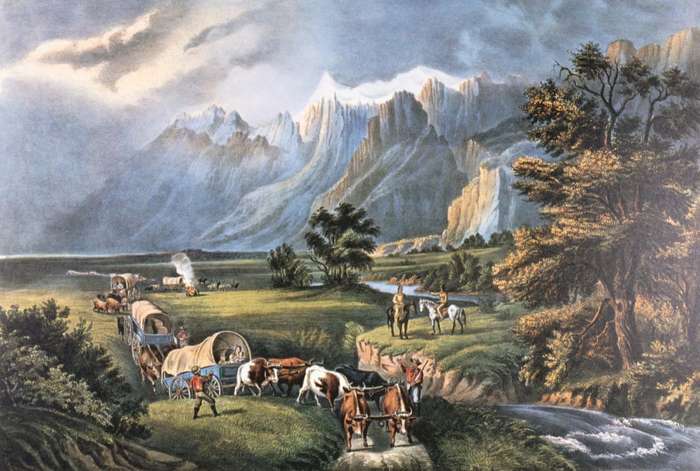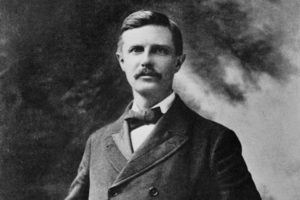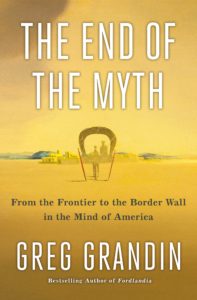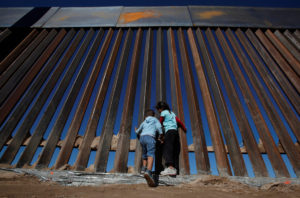With Limits: Dusk Sets on the American Frontier
A review of Greg Grandin’s book The End of the Myth: From the Frontier to the Border Wall in the Mind of America
 ‘A world of crystal light, a land without end, a space across which Noah and Adam might come straight from Genesis.’
‘A world of crystal light, a land without end, a space across which Noah and Adam might come straight from Genesis.’
-Owen Wister, The Virginian (1902)
‘So he drove out the man; and he placed at the east of the garden of Eden Cherubims, and a flaming sword which turned every way, to keep the way of the tree of life.’
-Genesis 3:24
‘I will build a great wall.’
-Donald Trump (2016)
Blazing alabaster white was the hue associated with the 1893 World’s Columbian Exposition in Chicago. A stunning marble-whiteness of plaster and cement, the buildings dappled in dazzling links of Thomas Edison’s incandescent light bulbs. Charles Smith of the New York Daily Tribune extoled this “wonderful group of buildings . . . created as if by magic.” Commissioner of Paris’ Central Union of Decorative Arts, Andrew Bouilhet, celebrated the exposition’s “domes . . . its colonnades, its porticoes, its terraces, its gardens filled with statues.” In a city razed by fire only a few decades before rose this temporary metropolis along the Midway Plaisance, as much Xanadu as Illinois.
Upon its incorporation in 1837, Chicago’s population was slightly under 5,000. During the year of the Columbian Exposition it was two million, the second largest city in the United States and fifth in the world. Chicago’s gleaming “White City” represented a triumph, the metropolis of the Transwestern frontier and the spiritual capital of the United States’ ever westward expansion. A fantastic, if not magical, place sprouted from prairie dust. Supposedly, when L. Frank Baum saw the resplendent Chicago he imagined that the white city was emerald, and so the Land of Oz was born.

Frederick Jackson Turner
A no less fantastic concept was born only a few miles from the fair at a meeting of the American Historical Association. There, an obscure assistant professor from the University of Wisconsin named Frederick Jackson Turner delivered a presentation with the staid title of “The Significance of the Frontier in American History.” The sparse audience had no questions for Turner, and, disappointed, he returned to Madison assuming that his radical hypothesis remained unheard. He had no such reason to fear, as Turner’s “Frontier Thesis” would become one of the central principles of nascent American Studies.
Yale University historian Greg Grandin explains Turner’s “Frontier Thesis” this way: As “the settlement line moved west . . . expansion came to be identified not just as a condition of freedom, but as freedom itself.” Turner’s frontier is meant to differentiate the United States from other nations, not just as a reality of the country’s geography, but as a type of consciousness too. Grandin writes that “only the United States has had a frontier, or at least a frontier that has served as a proxy for liberation . . . and held out as a model for the rest of the world to emulate.” Now, in The End of the Myth: From the Frontier to the Border Wall in the Mind of America, Grandin revises Turner’s thesis, judging not the accuracy of those claims, but asking whither the frontier today? And how do our fantasies endure in the Age of Trump? What Grandin has penned is effectively an obituary for American exceptionalism, or maybe more accurately a forensic pathology report about its demise.
Grandin is clear-eyed about how myths like the “Frontier” obscure the actual history of genocide and ethnic cleansing which marked Manifest Destiny, while also acknowledging what is useful in the metaphor. That Manifest Destiny has always meant barbarism, violence, and bloodshed is central to Grandin’s argument, and he enumerates in great detail the actual history of atrocity that marks movement towards the west. At the same time, the “Frontier” as a mythic concept separate from history could supply a potent vocabulary for democratic expansiveness. The End of the Myth is an astute, perceptive, sometimes inchoate but mostly well-argued account of how the “Frontier” and the “Border” have been held in contrast, and how we see the ascendancy of noxious fantasies which have replaced the frontier as unifying symbol. The demise of the “Frontier” as a metaphor – with connotations of freedom, mobility, and independence – has potentially profound cultural implications. Its replacement with the metaphor of the “Border” – with its connotations of enclosure, imprisonment, and surveillance – is even more disturbing.
When Turner delivered his paper in 1893, critical historiography as a quasi-scientific endeavor was new, theories of history less common than the Whiggish recounting of the great actions of great men. The nineteenth-century saw the development of more sophisticated scholarship, which considered social, economic, and cultural influences, and in imitation of the hard sciences (which the liberal arts increasingly looked up to as examples of progressive knowledge) developed models that explained the objective facts of history. Like many academic radicals, Turner was initiated into greatness by reacting to the stultifying orthodoxies of the late nineteenth-century; rather than standing on the shoulders of giants, Turner kicked out the shins of dwarves.
Turner was writing in response to “germ theory,” an explicitly elitist and racist account, which argued that our national qualities were an innate inheritance of ancient Teutonic peoples. Advocates like Hugh Henry Bancroft argued a white supremacist model of history, claiming that the “Aryan” peoples of northwestern Europe were genetically predisposed to qualities of individualism, freedom, and liberty. For Bancroft and other proponents of the germ theory (called as such since it saw WASP emigration to America like the spread of a benevolent bacillus), America’s national qualities were simply the result of unhampered white men. Whereas germ theorists held that the land was made by people, Turner inverted that contention.
Turner’s “The Significance of the Frontier in American History” rejects racial essentialism to explain the “exemplary” qualities of Americans, arguing that it was the frontier which defined the nation and made it exceptional. Turner enumerates American qualities as including a “practical, inventive turn of mind . . . masterful grasp of material things . . . restless, nervous energy . . . [the] buoyancy and exuberance which comes with freedom.” He claimed that such attributes have nothing to do with the “Saxon” origins of pioneers, but rather that the “peculiarity of American institutions is, the fact that they have been compelled to adapt themselves to . . . crossing a continent, in winning a wilderness.” It is worth mentioning that only three years before Turner stood on that Chicago dais celebrating America, the U.S. government massacred three-hundred Lakota women, children, and men at Wounded Knee, South Dakota.
 Stripped of the actual people affected by settler colonialism, “Frontier” becomes an unclear understanding of western movement as an actual step towards a brighter future, where Grandin writes that “Facing west meant facing the Promised Land, an Edenic utopia.” Turner preferred abstractions to the reality of Manifest Destiny, even though as a boy he would have been witness to his father’s role in the expulsion of Wisconsin’s Indians toward the setting sun (the historian’s middle name was in honor of Andrew Jackson). Such contradictions have always been subsumed into the frontier, so that reality serves the purpose of myth; facts are sublimated by metaphor, and regardless of what may have happened at Wounded Knee, the concept has defined American culture.
Stripped of the actual people affected by settler colonialism, “Frontier” becomes an unclear understanding of western movement as an actual step towards a brighter future, where Grandin writes that “Facing west meant facing the Promised Land, an Edenic utopia.” Turner preferred abstractions to the reality of Manifest Destiny, even though as a boy he would have been witness to his father’s role in the expulsion of Wisconsin’s Indians toward the setting sun (the historian’s middle name was in honor of Andrew Jackson). Such contradictions have always been subsumed into the frontier, so that reality serves the purpose of myth; facts are sublimated by metaphor, and regardless of what may have happened at Wounded Knee, the concept has defined American culture.
Grandin explains that Turner’s thesis assumes a mechanism whereby a “constant fleeing forward allowed the United States to avoid a true reckoning with its social problems, such as economic inequality, racism, crime and punishment, and violence.” It’s an innovative and convincing explanation of why the United States, unique among all Western countries, has never had a successful socialist movement. The End of the Myth argues that all tensions within eastern American society were sublimated and projected westward, the frontier promising for every person (who is white and male) their own individualist kingdom.
The United States was little different from revolutionary Europe, but our working class simply pulled up stakes and went further west at the exact same time that the French and German proletariat gathered in barricades. The frontier denied a hideous reality whereby white men could “win a greater liberty by putting down people of color, and then continuing to define their liberty in opposition to [them].” By providing analyses of both the Mexican War and the Spanish War, imperial wars that Americans high on their own sense of exceptionality know little about, The End of the Myth belies the point that the liberatory frontier was always that – a myth.
American stability was ensured by exporting violence into the ill-defined “Frontier,” and then redefining it as other things, from interstellar space to global markets. With no more frontier, the forces kept in check by our endless wanderings are unleashed at home, so that Grandin argues “Trumpism is extremism turned inward, all-consuming and self-devouring.” The End of the Myth is particularly good at demonstrating how Trumpism is hardly sui generis, that the border has always been a counter-melody to the idea of the frontier, though lacking in the redemptive possibilities of later. Whatever the frontier has meant, Grandin argues that the metaphor itself is now dead. The frontier has been replaced. America’s new metaphor is “The Wall.”
Historically, we have seen the frontier in our politics and our popular culture; it has been the organizing principle of American identity, if not from the moment the Mayflower docked at Plymouth, then certainly from when Turner gave a language to describe the phenomenon, this “magic fountain of youth in which America continually bathed and was rejuvenated.” Such was Turner’s injunction that claimed individualism and political freedom “came out of the American forest and it gained strength each time it touched a new frontier,” though history teaches us that the model has flaws. After all, the new frontier was how President John F. Kennedy talked of outer space, though it was also how his administration talked about Vietnam.
There is a suggestion, however, that one dangerous faith can be replaced with a worse one. A paradise lost may have never been a paradise at all. But we should avoid replacing Eden with perdition. Turner argued that the days of the frontier were literally over, that the white space of terra incognita had been filled in; nothing was without jurisdiction, nothing wasn’t within a state or territory, nothing wasn’t administered by some authority. Over the following decades, frontier would come to signify variable and often opposed concepts, from civil rights to free market globalization. As an ideology, liberal universalism made use of “frontier Americanism,” a dogma of American exceptionalism.

U.S.-Mexico Border Wall
If triumphalists have historically configured America as a utopian religion, then we’ve entered an era of apostasy. Liberated from its historical exactitude by envisioning a frontier that existed everywhere, there was sometimes an emancipatory language that conceived of striving, yearning, and progress implicit within the concept. Now, we don’t even have the rhetoric; it’s been replaced with the authoritarian border. By claiming that the evaporation of the frontier mythos has abolished American exceptionalism, thus presenting an entry point for Trumpism, Grandin provides a map for how we got to this moment. Suddenly, our historical wars against Mexico and Spain, Cuba and the Philippines, Vietnam and Iraq, come home in the form of a rising fascism that we long exported. As the frontier was once everywhere, we now find that the border is too.
For those of us opposed to this current season of revanchism, there should be no illusions anymore. All that was repressed is on the surface, all that was subtext is text, the dog whistles are just whistles. For an era so defined by fakery, illusion, and subterfuge, an ironic honesty reigns supreme, the better to take aim at the ghouls that are ascendant. While some pine for a return to “normalcy,” there is no going back. Grandin gestures towards a different frontier, paraphrasing Rosa Luxemburg by writing that “Coming generations will face a stark choice . . . between barbarism and socialism, or at least social democracy.” If the sun is not to set on the American experiment, we must admit that there is no more West towards which we can move, but that does not mean there aren’t new frontiers that we can discover. As Grandin’s stark choice between socialism and barbarism evidences, we can perhaps refigure the idea of the frontier into a new idiom, where that westward movement becomes a metaphor for increasing egalitarianism, justice, and democracy.
Ed Simon is a staff writer at The Millions and the Editor-at-Large of The Marginalia Review of Books, a channel of The Los Angeles Review of Books. He holds a Ph.D. in English from Lehigh University and is a frequent contributor at several different sites. His collection America and Other Fictions: On Radical Faith and Post-Religion was published by Zero Books in 2018. He can be followed at his website, on Facebook, or on Twitter @WithEdSimon.
***
Published with support from the Henry R. Luce Initiative on Religion in International Affairs.